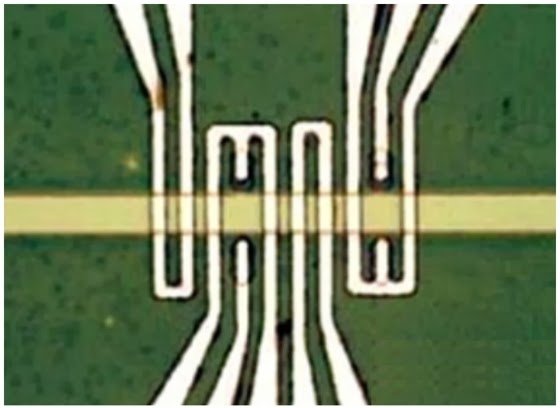UCLA researchers were able to demonstrate that using multiferroic material to generate spin waves could reduce wasted heat and therefore increase power efficiency for computer processing by up to 1,000 times.
Multiferroic magnetic materials reduce the amount of power consumed by “logic devices,” a type of circuit on a computer chip dedicated to performing functions such as calculations. A multiferroic can be switched on or off by applying alternating voltage — the difference in electrical potential. It then carries power through the material in a cascading wave through the spins of electrons, a process referred to as a spin wave bus.
A spin wave can be thought of as similar to an ocean wave, which keeps water molecules in essentially the same place while the energy is carried through the water, as opposed to an electric current, which can be envisioned as water flowing through a pipe, said principal investigator Kang L. Wang, UCLA’s Raytheon Professor of Electrical Engineering and director of the Western Institute of Nanoelectronics (WIN).
“Spin waves open an opportunity to realize fundamentally new ways of computing while solving some of the key challenges faced by scaling of conventional semiconductor technology, potentially creating a new paradigm of spin-based electronics,” Wang said.
Spin wave devices – A picture of spin wave devices, showing magneto-electric cells used for voltage-controlled spin wave generation in the spin wave bus material (yellow stripe). The yellow stripe is about four micrometers in diameter.
“Electrical control of magnetism without involving charge currents is a fast-growing area of interest in magnetics research,” said co-author Pedram Khalili, a UCLA assistant adjunct professor of electrical engineering. “It can have major implications for future information processing and data-storage devices, and our recent results are exciting in that context.”
ABSTRACT
In this work, we report on the demonstration of voltage-driven spin wave excitation, where spin waves are generated by multiferroic magnetoelectric (ME) cell transducers driven by an alternating voltage, rather than an electric current. A multiferroic element consisting of a magnetostrictive Ni film and a piezoelectric [Pb(Mg1/3Nb2/3)O3](1−x)–[PbTiO3]x substrate was used for this purpose. By applying an AC voltage to the piezoelectric, an oscillating electric field is created within the piezoelectric material, which results in an alternating strain-induced magnetic anisotropy in the magnetostrictive Ni layer. The resulting anisotropy-driven magnetization oscillations propagate in the form of spin waves along a 5 μm wide Ni/NiFe waveguide. Control experiments confirm the strain-mediated origin of the spin wave excitation. The voltage-driven spin wave excitation, demonstrated in this work, can potentially be used for low-dissipation spin wave-based logic and memory elements.
SOURCES – UCLA, Applied Physics Letters
If you liked this article, please give it a quick review on ycombinator or StumbleUpon. Thanks

Brian Wang is a Futurist Thought Leader and a popular Science blogger with 1 million readers per month. His blog Nextbigfuture.com is ranked #1 Science News Blog. It covers many disruptive technology and trends including Space, Robotics, Artificial Intelligence, Medicine, Anti-aging Biotechnology, and Nanotechnology.
Known for identifying cutting edge technologies, he is currently a Co-Founder of a startup and fundraiser for high potential early-stage companies. He is the Head of Research for Allocations for deep technology investments and an Angel Investor at Space Angels.
A frequent speaker at corporations, he has been a TEDx speaker, a Singularity University speaker and guest at numerous interviews for radio and podcasts. He is open to public speaking and advising engagements.


